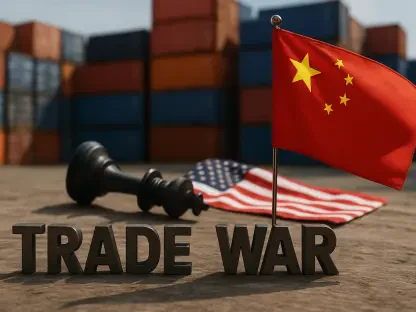Economic uncertainty is a silent disruptor that affects economic decisions ranging from starting businesses to investing in new ventures or even buying homes. This article tackles the growing economic uncertainty in the United States as of March 17, 2025, and the mixed signals that analysts and citizens are receiving from various economic indicators.
Measuring Economic Uncertainty
The Economic Policy Uncertainty Index
One of the primary measures of economic uncertainty discussed in the article is the Economic Policy Uncertainty (EPU) Index for the United States, which is tracked by the St. Louis Federal Reserve’s FRED database. The EPU Index, developed by economists Scott R. Baker, Nick Bloom, and Steven J. Davis, incorporates three elements: the frequency of newspaper articles highlighting economic uncertainty related to policy, the number of federal tax code provisions approaching expiration, and the spread of disagreement among forecasters on topics such as inflation and government spending. The index, normalized to an average of 100 from 1985 to 2010, has risen above 150 in recent weeks, comparable to spikes witnessed during the Great Recession and the COVID-19 pandemic.
A notable rise in the Global Economic Policy Uncertainty Index mirrors this trend, indicating a broader wave of unease that transcends U.S. borders. Despite the concerning signals from the EPU Index, other economic indicators present a conflicting narrative. While the EPU Index points to heightened anxiety, the broader economic landscape exhibits more resilience than what the media-driven panic suggests. This contrast implies the necessity to look beyond one indicator to gauge economic health comprehensively.
The Discrepancy with Other Indicators
The CBOE Volatility Index (VIX), often referred to as Wall Street’s “fear gauge” because it measures expected stock market swings via options on the S&P 500, remains relatively steady. As of mid-March 2025, the VIX hovers close to its long-term average, suggesting that investors are not bracing for a market meltdown. This steadiness amidst the turbulent policy signals provides some comfort to investors seeking stability in a landscape marked by uncertainty.
Furthermore, analysts observe a divergence between stock market volatility measured by the VIX and the policy-driven concerns reflected in the EPU Index. This discrepancy points to a potential delay in market reactions to policy changes. Historical instances, such as the 2011 debt ceiling crisis when the EPU Index spiked significantly but the VIX remained unaffected, underscore that policy uncertainty does not always result in immediate market upheaval. Investors might be holding confidence in the economy’s underlying resilience, waiting for definitive signals before making drastic moves.
Business Sentiment and Market Stability
Business Outlook and Survey Results
Furthermore, business sentiment as measured by the Federal Reserve Bank of Atlanta’s Survey of Business Uncertainty paints a less dire picture. This survey, which queries firms about their 12-month sales and employment forecasts and their confidence level, indicates that businesses are not experiencing a significant surge in uncertainty. Compared with late 2024, when businesses were rattled by tariff threats and election uncertainties, the current climate appears calmer. The survey results suggest that while companies are cautiously optimistic, they are proceeding with confidence despite the policy-related noise. This cautious optimism among business leaders is a crucial factor for maintaining economic momentum.
In addition, examining business sentiment through these surveys reveals the adaptability of firms to changing political landscapes. Business leaders, seasoned in navigating uncertainties, continue to make strategic decisions, indicating resilience. The absence of marked panic in business forecasts reinforces the notion that policy-induced uncertainty needs a balanced perspective, recognizing both potential risks and the innate stability of many enterprises.
Historical Context and Trends
The divergence between the EPU Index and other measures of market stability, such as the VIX and business surveys, is not unprecedented. For example, during the 2011 debt ceiling crisis, the EPU Index soared while the VIX remained muted. This discrepancy suggests that while policy uncertainty is certainly present, the financial and operational responses may lag until the potential impacts become more imminent and clear. These historical patterns underscore the limited predictive power of uncertainty indexes when isolated.
During moments of political turbulence, such as the recent tariff maneuvers and fiscal gridlocks, businesses and investors have often demonstrated resilience that belies the apprehension shown by uncertainty indices. By examining past instances, it becomes apparent that economic stability can withstand policy-induced shocks to a significant degree. Thus, while EPU captures sentiment-driven uncertainty, actual economic performance might pivot on varied factors beyond immediate policy shifts, emphasizing the need for a comprehensive approach in risk assessment.
Factors Contributing to Economic Uncertainty
Political Influence
Several factors contribute to the complexity of economic uncertainty in early 2025. Firstly, political decisions, particularly President Trump’s inconsistent tariff policies and his open discussions about recession risks, have triggered a rise in the EPU Index. Trump’s tariff announcement on March 14, 2025, regarding Canada, which was swiftly reversed within hours, is an example of the kind of political unpredictability causing economic anxiety. These abrupt shifts in policy not only stir immediate uncertainty but resonate through economic planning and forecasting, compelling businesses and investors to act cautiously.
The unpredictability of political actions like tariff reversals casts a shadow over the certainty with which financial decisions are made. Political inconsistency feeds into the broader narrative of a volatile economic environment, challenging stakeholders to navigate less predictable pathways. This political climate, featuring swift changes and frequent reversals, contributes significantly to the heightened EPU Index, mirroring public sentiment and media portrayal.
Financial Instability Indicators
Secondly, inflation remains a persistent concern, although it showed some easing in February’s data. The Federal Reserve has remained cautious, with a 97% likelihood of no rate cuts at the forthcoming March 19 Federal Open Market Committee (FOMC) meeting, according to the CME’s Fed Watch tool. Additionally, the uncertainty is further fed by widely varying credit spreads and volatile 10-year Treasury yields, indicating underlying financial instability. These financial indicators underscore the complexities embedded within the broader economic environment, highlighting areas of instability that could react unpredictably to policy shifts.
Inflation trends and interest rate decisions are pivotal in shaping the direction of economic activities. The Federal Reserve’s cautious stance reflects its efforts to mitigate risks in an already uncertain landscape. Credit spreads and Treasury yields, significant markers of financial health, display volatility, adding layers of complexity to economic predictions. The multi-faceted nature of these indicators suggests that economic uncertainty is a composite of interrelated factors, each contributing uniquely to the broader picture of fiscal stability.
The Current Economic Landscape
Resilience Amid Uncertainty
While the EPU Index points to substantial policy-induced uncertainty, other markers lag in showing the same level of concern. The steady VIX and unimpressed business sentiment suggest a skepticism towards the doomsday narrative often amplified by the media. It’s important to recognize that the EPU Index, deeply rooted in media representation, may be amplifying drama over substantial changes. Businesses and investors, accustomed to dealing with fluctuating political landscapes, may be showing a resilience not captured by the EPU Index. This displays an understated confidence within segments of the economy, indicating that while caution is prevalent, there isn’t widespread panic.
The resilience exhibited by businesses and market players paints a nuanced picture of economic health, suggesting that while policy shifts create uncertainty, the response isn’t uniformly negative. This resilience might be rooted in long-term strategies and adaptive measures formulated through past experiences of similar volatility. The resistance to immediate panic reflects an ecosystem of economic stakeholders who balance risk with strategic foresight, navigating complexity without succumbing to fear-driven reactions.
Historical Patterns
Meanwhile, historical context underscores the limited predictive power of uncertainty indexes alone. For instance, despite the media frenzy during the 2011 debt ceiling crisis, markets maintained stability. This phenomenon suggests that while policy-induced uncertainty is undeniable, its translation into tangible economic outcomes can vary significantly. Economic stakeholders often rely on historical patterns to assess future risks, identifying periods where despite high uncertainty indices, the actual economic fallout was minimal.
This pattern underscores the necessary approach of tempering media-driven narratives with empirical evidence from historical events. Thus, while uncertainty indices like EPU capture the zeitgeist of apprehension, they don’t always correlate with immediate market disarray. This balanced perspective aids in informing strategic decisions, helping businesses and investors to respond with measured actions. The historical lens provides context for current phenomena, aiding in distinguishing between temporary upheavals and substantive economic threats.
The current economic landscape in the U.S., though uneven, remains active, with signs pointing towards a cautious watchfulness rather than a full-blown panic. The interplay of policy uncertainty, market confidence, and historical resilience will shape the U.S. economic trajectory in the months to come, demanding close observation and adaptive responses from stakeholders across the spectrum.
Conclusion
Economic uncertainty is a quiet disruptor influencing decisions on a broad scale, from launching new businesses and investing in fresh ventures to purchasing homes. This article delves into the rising economic uncertainty in the United States as of March 17, 2025. Both analysts and everyday citizens are encountering mixed signals from a variety of economic indicators. Some signs suggest optimism and growth, while others reflect instability and caution. This conflicting information complicates the decision-making process for businesses planning expansions, investors looking into new opportunities, and families considering home ownership. The overall sentiment is one of hesitation and careful planning as the nation navigates through these uncertain times. Understanding these complex dynamics is crucial for anyone involved in the economic landscape, as it impacts everything from market trends to individual financial strategies. This article aims to shed light on these issues, offering insights into how to manage and adapt to the ongoing economic challenges effectively.









